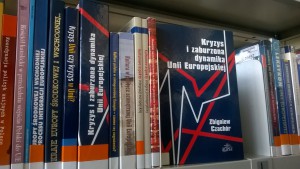
For over sixty years the questions concerning the dynamics and crises of European integration have been asked over and over again. Why has crisis and malfunctioning become a permanent feature of the system of the Communities, and then the European Union? How should their disturbances be interpreted and understood? Is the present period of ‘Sturm und Drang’ and extraordinary circumstances a time to either implement or give up the federal dream of the imperial United States of Europe?
The second decade of the 21st century is turning into an extremely difficult period of reforms and modifications in the European Union. Nobody can be certain when and how it will come to an end. We do not know whether we are facing a developmental breakthrough or the disintegration and collapse of the European project. We are wondering whether the EU is capable of governing itself and overcoming the crises that have impacted it. Is the EU still able to generate and regenerate itself, using exclusively its own powers and elements? Has the present model of the evolution of European integration, based on the ongoing overcoming of crises and achieving a new state of equilibrium every time, become exhausted, bringing the European Union to a state of crisis? These are only a few of the questions being addressed by researchers, analysts, experts, as well as the politicians and officials who are in charge of European matters.
This study is primarily focused on the theoretical and conceptual approach to the issue of irregularities in the European Union, including the forecasts and projections of the transformations and changes that will occur in the future. In this context, the purpose is to present the author’s perception of what ‘crisis’ means, the reception, interpretation and adaptation of numerous theories, concepts and theoretical approaches, as well as visions, evaluations and views in terms of European integration, international relations, philosophy, sociology, law, politics and economics. It is to assist in inductive and deductive explaining and understanding of the determinants and dependent and independent variables which define the analytically identifiable disturbances in the dynamics of European Union integration.
This publication is neither a monographic history of the theory of European integration and European Union studies, nor a history of integration crises and of the EU. It does not pretend to provide a compendium or a crisis (anti-crisis) handbook.
Each chapter of this book constitutes a separate study with its own theoretical input and literature, and which could be published separately. With respect to some issues, the same could apply to individual subchapters and topics of this work. Each chapter ends with a recapitulation which includes conclusions as well as the author’s remarks and comments on the content of the chapter. This allows the reader to dip into the book wherever they wish. This does not alter the research purpose, which assumes that someone willing to truly understand integration crises should analyze the whole content of the publication.
The author’s objective is to search for an answer to the research question posed making reference to a range of theories, theoretical approaches and methods (research tools) while not necessarily assessing which provides the most adequate way of understanding the sources and direction of European integration crises. A separate empirical section has been deliberately abandoned, as these are included in many other studies developed in response to the integration crises of the past fifteen years.
It has already been highlighted that each part of the publication is developed so as to make a thorough presentation of the state of research, which was very important, but also to reflect the analytical thought serving the purpose of explaining and understanding the reasons and circumstances of integration crises. As a principle, the author consciously does not focus on his own or external criticism of various presentations of disturbances of reality and problems in the functioning of the European Union. This is clearly justified as an overabundance of conflicting and mutually exclusive approaches merely forces the reader, and the author, to work out for himself which is the most accurate in describing the past, present and future of the EU.
The publication is designed so that everyone interested can:
- focus his attention primarily on the actors of integration (mainly on EU states and institutions) assuming that the definition of an institution differs depending on the theoretical approach adopted;
- join the debate that is rooted in unlimited inspiration and conceptual adaptation serving the purpose of explaining and understanding of what seems neither explained nor understood in the integration crisis.
The references to various theoretical approaches toward the reality of integration in the circumstances of a crisis follow from the author’s attempts to introduce to the academic debate epistemological adaptations, generalizations and conclusions from a multifaceted analysis of selected causes and premises of disturbances in European Union system. It is assumed that discovering the regularities and laws that govern the inhibitions of European integration, including various theoretical approaches, will allow us to understand that the European Union is a dynamic, pluralistic ‘new generation’ organization which is constantly being thrown off balance.
The analysis of the theories, concepts and research attitudes mentioned in the book serves the purpose of monitoring how academia is dealing with the explanation of the malfunctioning of the European Union. This is not a completed process. Therefore, an experimental outlook is also taken into account, being more than an intellectual, or semantic research game.
The study could not neglect making references to the anti-crisis activities of the European Union and its members, including the activities involving the indication of new methods, means and instruments to combat destabilization applied in the practical solving of the most crucial integration problems.